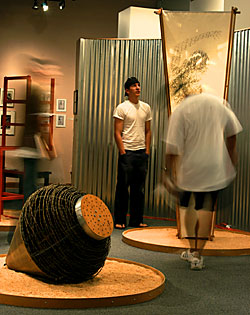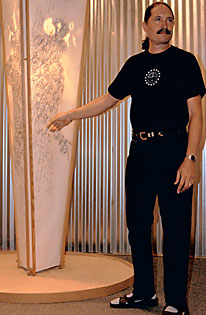 |
|
MELISSA HALTERMAN/Arizona Summer Wildcat
|
Students from a Pima Community College art appreciation class tour the staff exhibit at the Arizona State Museum. This time lapse photo portrays the work of Martin Kim.
|
|
By Aaron Mackey
Arizona Summer Wildcat
Wednesday July 23, 2003
Arizona State Museum employees showcase their own art for the first time in museum history
The staff at the Arizona State Museum isn't used to being in the spotlight. They usually greet visitors and point them to the spotlight. But the new exhibit, "After Hours," brings the staff out from behind the scenes and into the public eye. The exhibit features artwork ranging from photography to model trains from 40 staff members.
Pointing viewers in the direction of the art isn't anything new for some of the artists.
The job of the artist is to point the audience in the direction of the art, but the audience often misses the meaning of the art and sees only the presentation, said Martin Kim, museum store manager and program coordinator for the museum, who has work displayed in the exhibit.
"We have come to celebrate the well-crafted object, and sometimes make a hero of the artist executing it öö seldom looking beyond to see where it may all be pointing," Kim said in his artist's statement.
This unique and charming exhibit, which began July 2 and will run through July 25, is the first time in museum history that an exhibit featuring the works of employees and volunteers was unveiled to the public, said Kim.
Kim said that the exhibit's purpose was to "bring focus and attention to the preoccupation of our staff."
Kim also said that there was a vast number of talented staff that deserved a gallery showing.
 |
|
This is an opportunity for everybody to get into what art is about and to broaden what we know about each other
- Martin Kim
Museum Store Manager and Program Coordinator
|
 |
Staff and museum volunteers put forth pieces ranging from photographs and paintings to sculptures and quilts.
Museum photographer Jannelle Weakly said that during the planning of the exhibit, many employees would come to her with concerns and say, "I'm not an artist."
Weakly said that by allowing for all different types of entries, such as one employee's collection of model trains, art can be seen as a form of personal expression.
"We're just in complete awe of what (the employees and volunteers) are able to do," she said.
"This is a great opportunity for everybody to get into what art is about, and to broaden what we know about each other," Kim said.
Kim's work, entitled "Three Ring Circus," stands out with its three unique pieces capturing the eye.
The first piece of the work, entitled "He Said/She Said," is a red reversible chair made from wood. Kim said the piece speaks to human relationships, as one person is constantly unseated and balanced by another.
"Little Top" is a large top composed of fiberglass, wood and barbed wire that sets up an immediate contrast in the viewer's eye.
The juxtaposition of a top wrapped in barbed wire conjures up images of playfulness and danger in the same moment.
 |
|
MELISSA HALTERMAN/Arizona Summer Wildcat
|
Martin Kim, Project Coordinator for the Arizona State Museum discusses his work "The Barker".
|
|
Kim said that the contrast was purposeful, meant to provoke thought and reflection.
Kim added that the piece conjures up images of Jews imprisoned in the Holocaust because the top resembles a dreidel.
The most profound piece of Kim's "Three Ring Circus" comes in the tri-paneled self-portrait of sorts entitled "The Barker."
Kim traced his outline in several different positions as if he were shouting out to passers-by.
The silhouettes are filled with the words, "It is the impeded stream that sings," part of a quote by one of Kim's favorite philosophers.
A revolving light inside the piece projects images such as a cross and concentric circle through the heads of the silhouettes, as if they are traveling through Kim's mind.
While Kim would not go into the details of the meaning of the piece to him, he said that the images represent parts of life that a person experiences, and that they will need to be repeated again.
According to Kim, the three-piece work had been sitting in his living room for the past four years after once being on display for the Tucson/Pima Arts Council.
Weakly, who doesn't consider herself an artist, also has work on display.
Her collection of photographs is entitled "People on the Stairs," and, accurately enough, displays images of people laughing and living while standing on a staircase.
Weakly said the work was done by accident; she took the pictures in order to get a better idea of the lighting.
Smiling faces and awkward expressions capture happy moments in life to create an endearing quality to the piece.
The exhibit is not the first display of employee and volunteer creativity. However, it is the first time that the public will actually get to have a look, Kim said.
Exhibits of this nature were held in the past as fundraisers and to boost staff morale, he said.
Jared Worley, a student at Azusa Pacific University in California, said that knowing the work came from employees and volunteers enhanced his experience at the exhibit.
"It makes you appreciate it more. It's not their pride in their work, but their pride in their jobs that shows through," he said.
The "After Hours" exhibit offers guests a chance to view a side of the museum that is not often seen, with employees and volunteers expressing their artistic flair.
In visiting the exhibit, the public is given the unique chance to connect with not only the art, but also the artists, who are more than likely the people showing you through the exhibit or smiling at you on your way in.

